Abstract
Increased iron content of cells and tissue may increase the risk of cancer. In particular, high available iron status may increase the risk of a radiation-induced cancer. There are two possible mechanisms for this effect: iron can catalyze the production of oxygen radicals, and it may be a limiting nutrient to the growth and development of a transformed cell in vivo. Given the high available iron content of the western diet and the fact that the world is changing to the western model, it is important to determine if high iron increases the risk of cancer.
Full text
PDF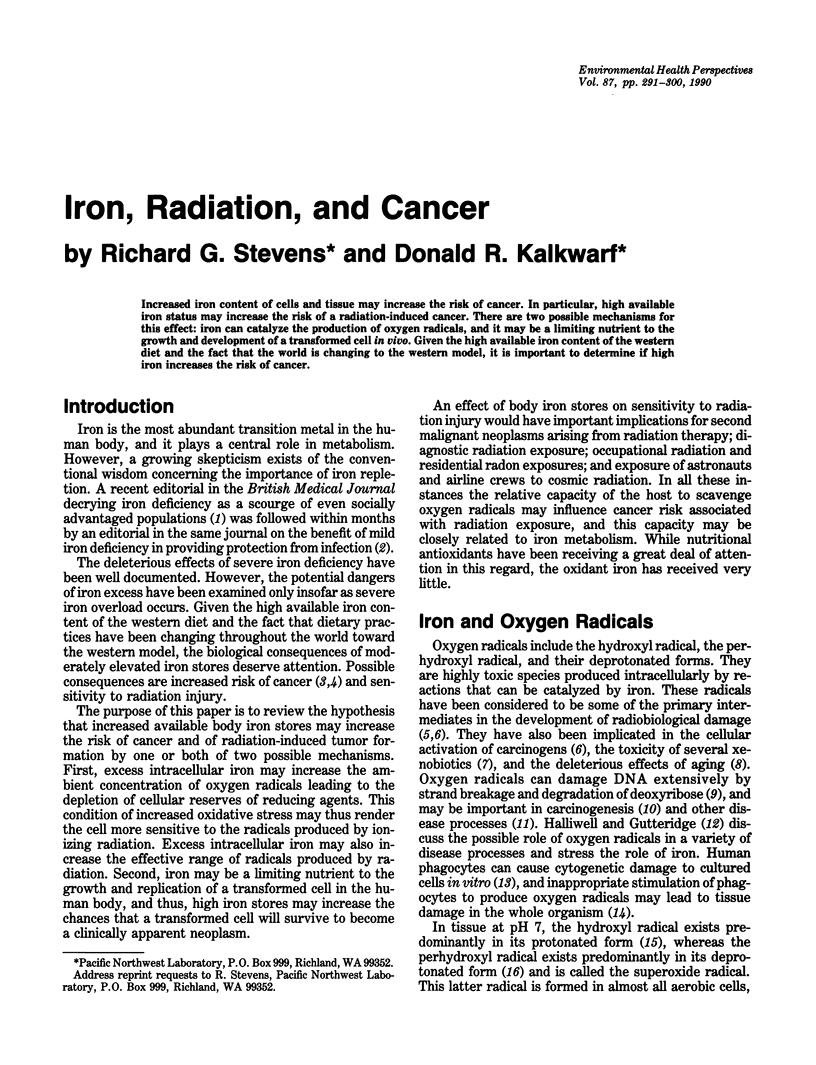
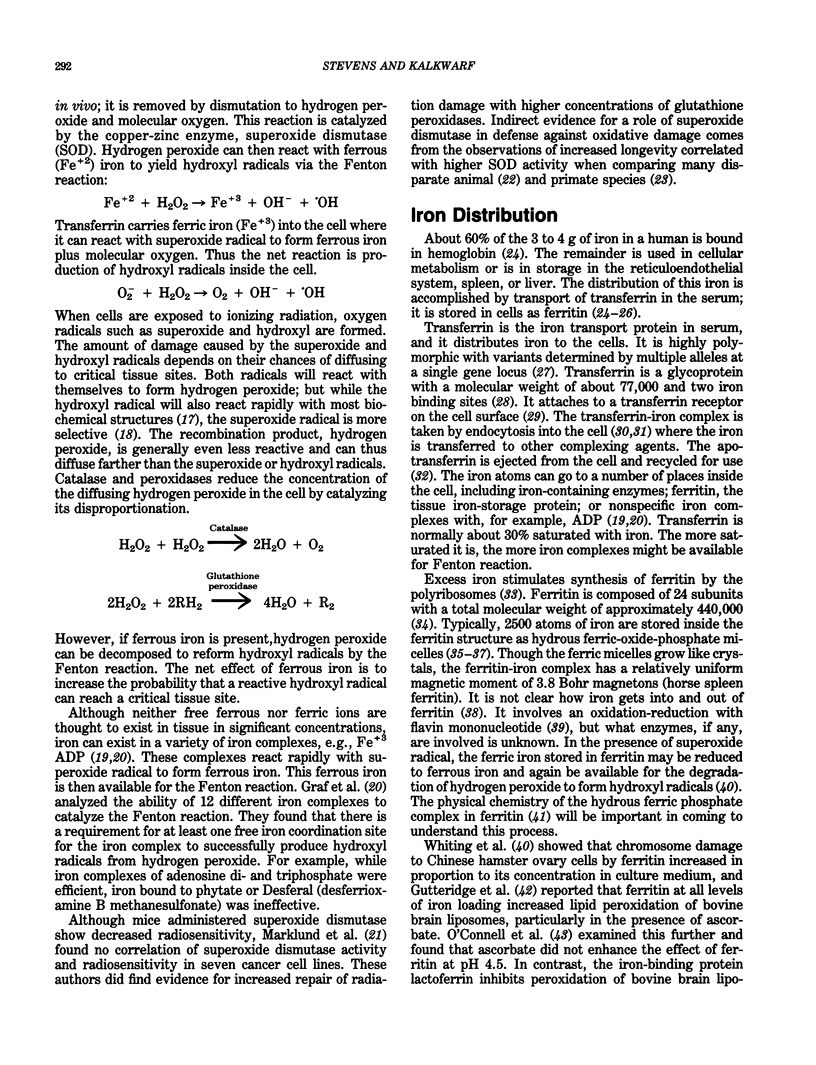
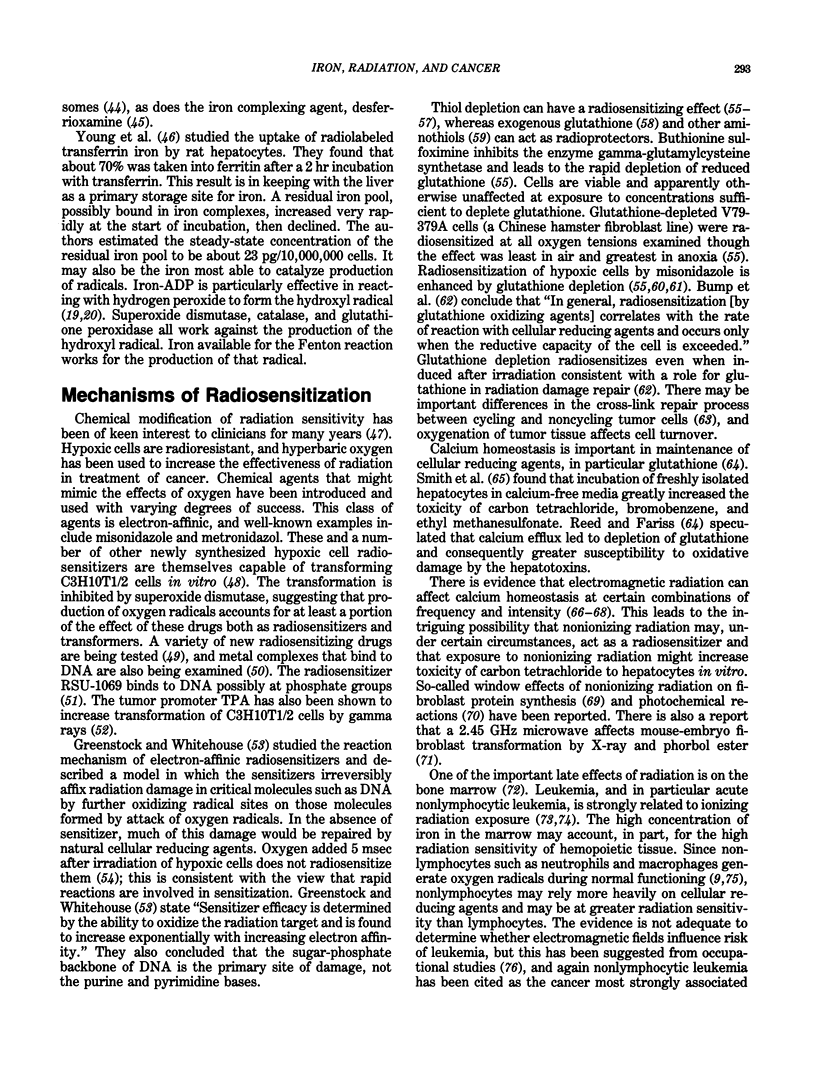
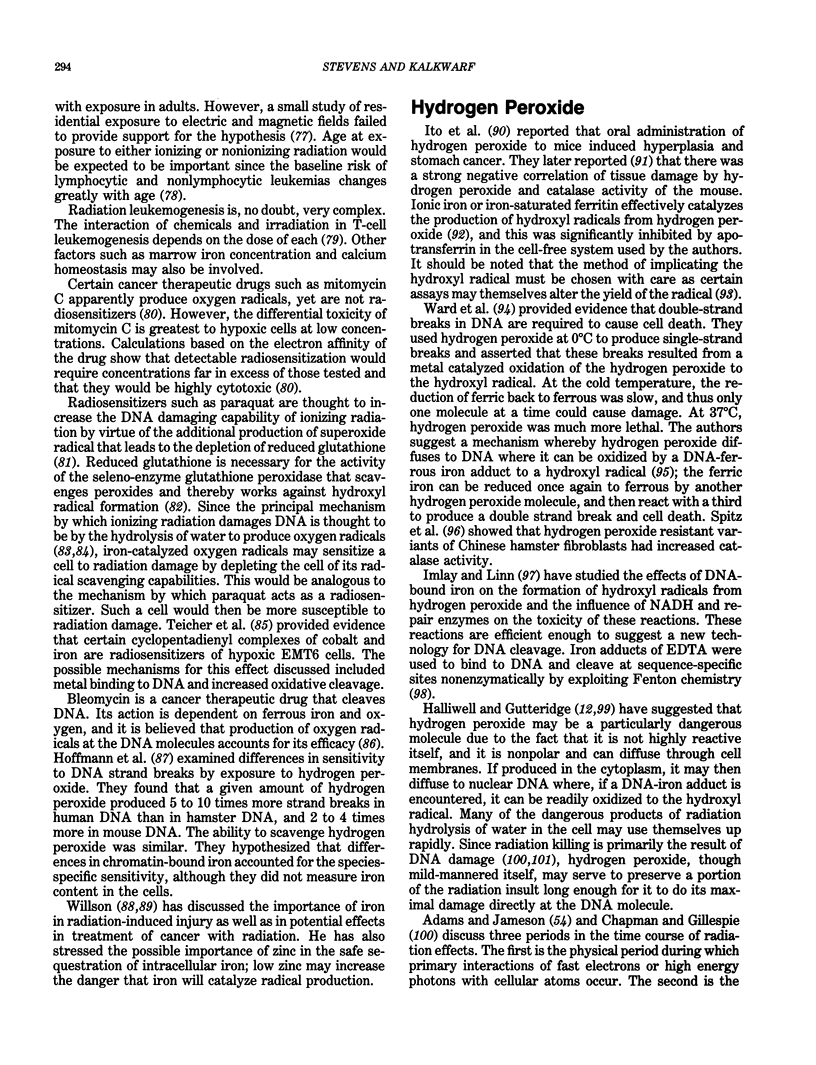

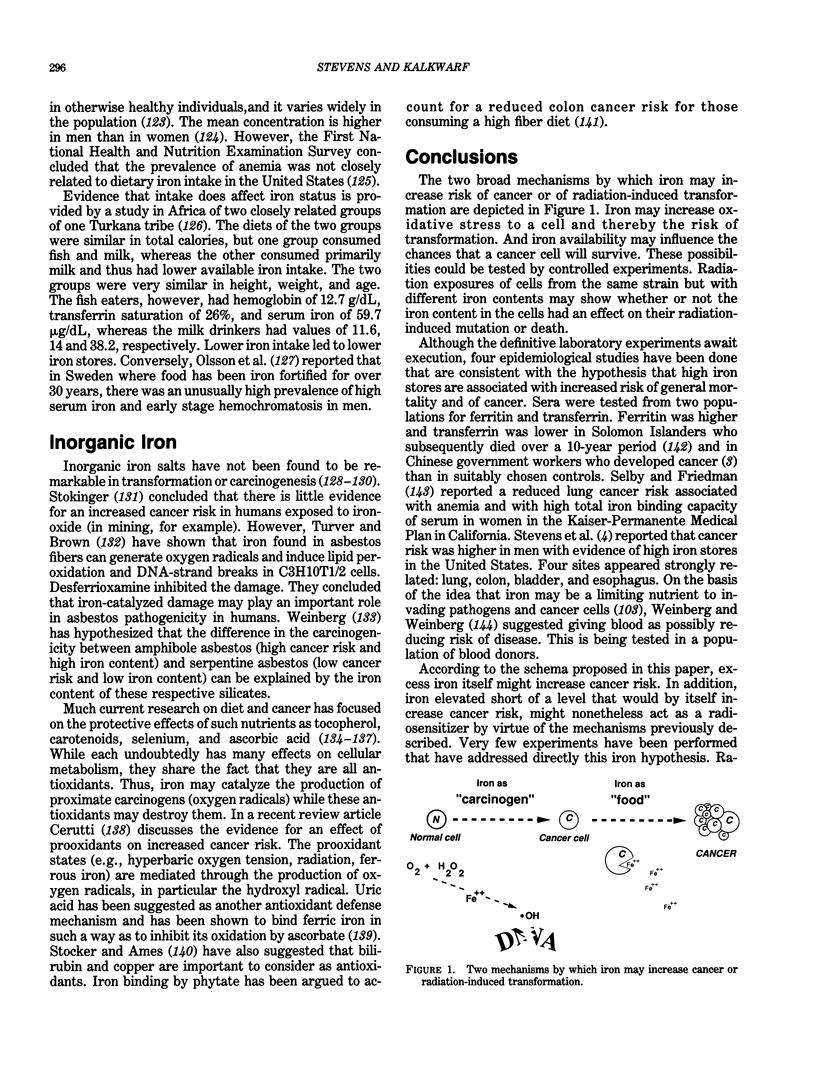
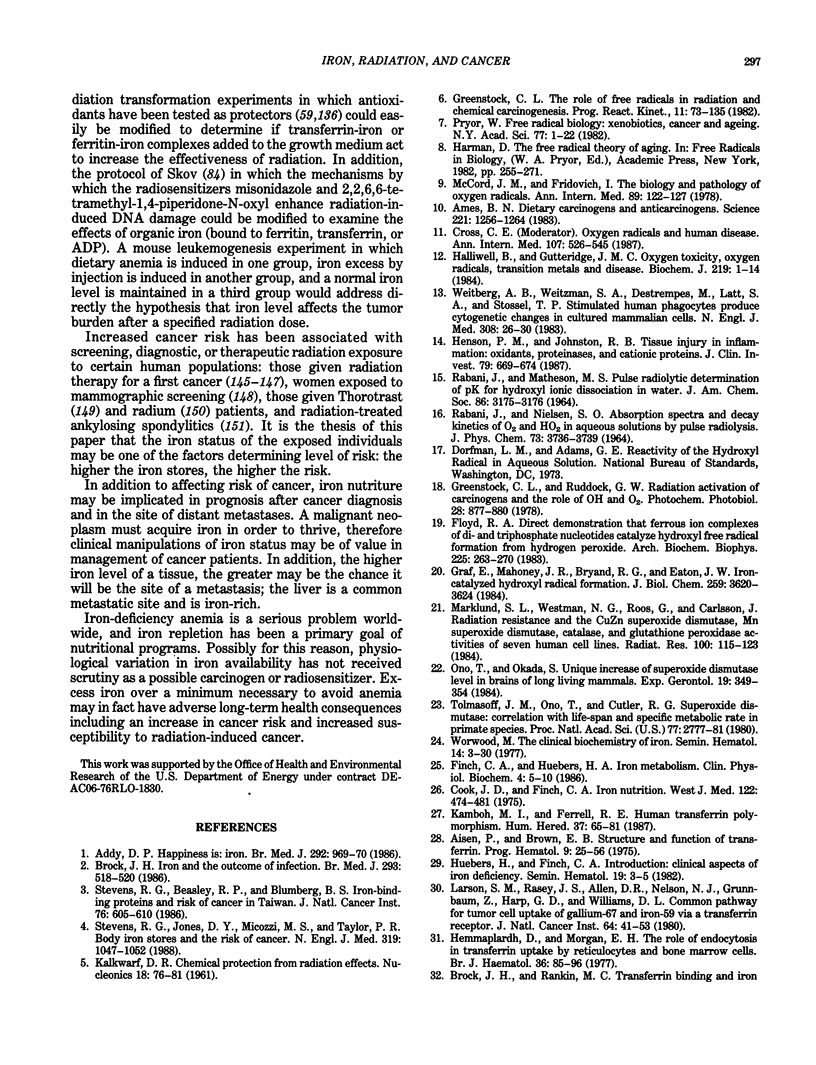
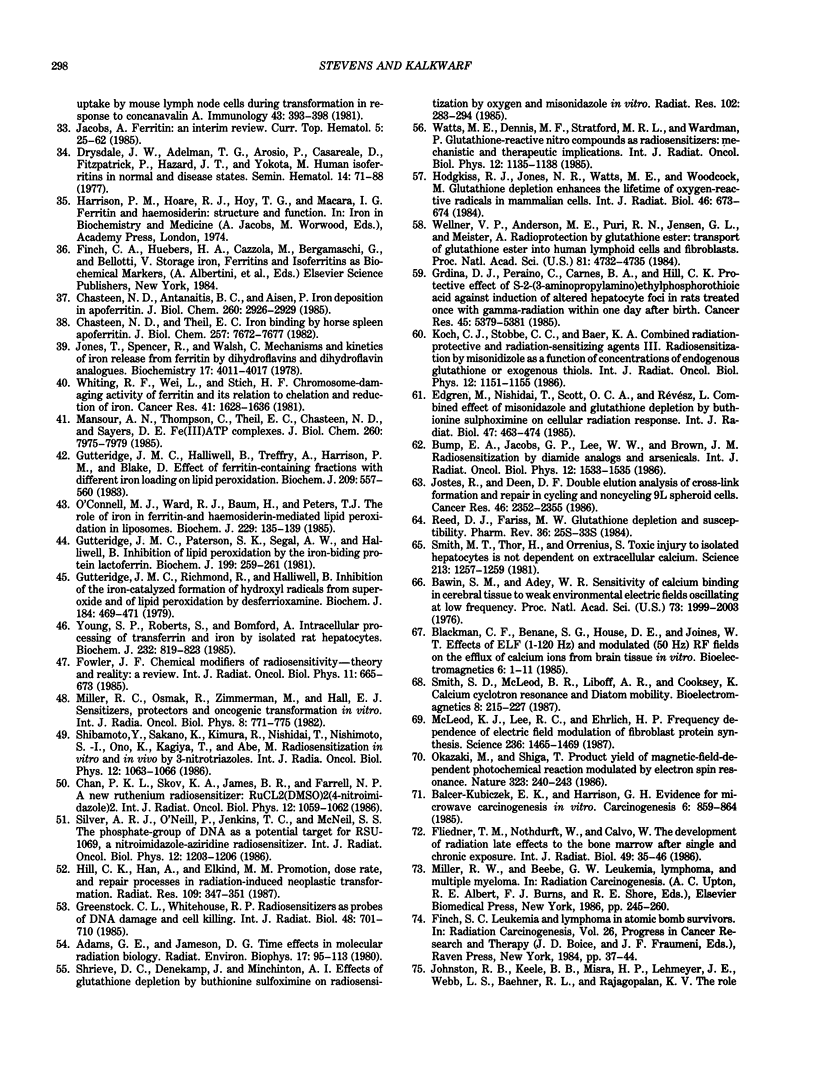
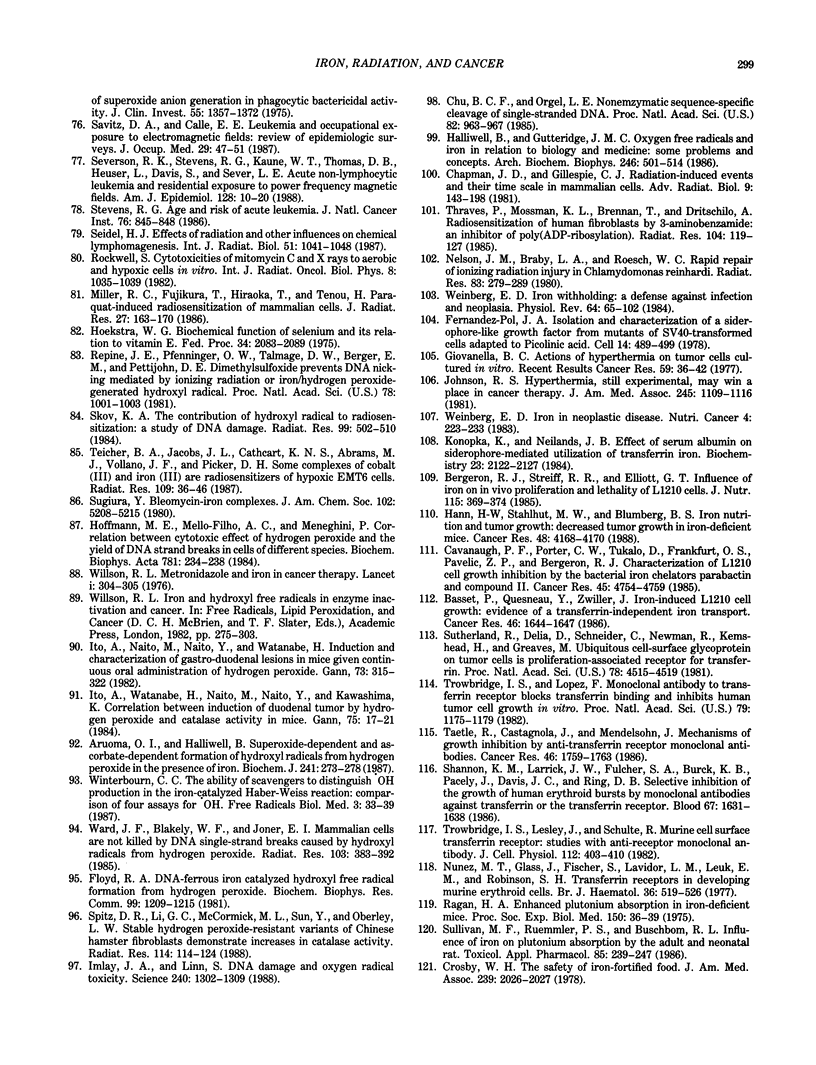
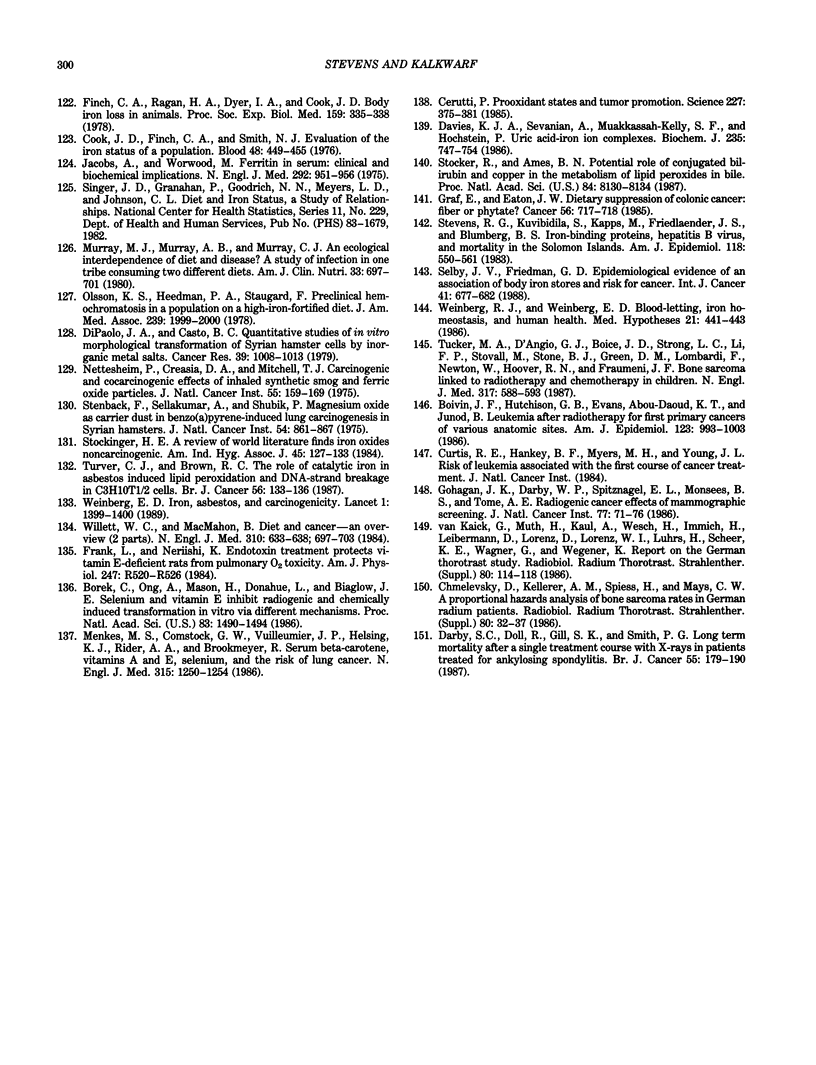
Selected References
These references are in PubMed. This may not be the complete list of references from this article.
- Adams G. E., Jameson D. G. Time effects in molecular radiation biology. Radiat Environ Biophys. 1980 Feb;17(2):95–113. doi: 10.1007/BF02027847. [DOI] [PubMed] [Google Scholar]
- Addy D. P. Happiness is: iron. Br Med J (Clin Res Ed) 1986 Apr 12;292(6526):969–970. doi: 10.1136/bmj.292.6526.969. [DOI] [PMC free article] [PubMed] [Google Scholar]
- Aisen P., Brown E. B. Structure and function of transferrin. Prog Hematol. 1975;9:25–56. [PubMed] [Google Scholar]
- Ames B. N. Dietary carcinogens and anticarcinogens. Oxygen radicals and degenerative diseases. Science. 1983 Sep 23;221(4617):1256–1264. doi: 10.1126/science.6351251. [DOI] [PubMed] [Google Scholar]
- Aruoma O. I., Halliwell B. Superoxide-dependent and ascorbate-dependent formation of hydroxyl radicals from hydrogen peroxide in the presence of iron. Are lactoferrin and transferrin promoters of hydroxyl-radical generation? Biochem J. 1987 Jan 1;241(1):273–278. doi: 10.1042/bj2410273. [DOI] [PMC free article] [PubMed] [Google Scholar]
- Balcer-Kubiczek E. K., Harrison G. H. Evidence for microwave carcinogenesis in vitro. Carcinogenesis. 1985 Jun;6(6):859–864. doi: 10.1093/carcin/6.6.859. [DOI] [PubMed] [Google Scholar]
- Basset P., Quesneau Y., Zwiller J. Iron-induced L1210 cell growth: evidence of a transferrin-independent iron transport. Cancer Res. 1986 Apr;46(4 Pt 1):1644–1647. [PubMed] [Google Scholar]
- Bawin S. M., Adey W. R. Sensitivity of calcium binding in cerebral tissue to weak environmental electric fields oscillating at low frequency. Proc Natl Acad Sci U S A. 1976 Jun;73(6):1999–2003. doi: 10.1073/pnas.73.6.1999. [DOI] [PMC free article] [PubMed] [Google Scholar]
- Bergeron R. J., Streiff R. R., Elliott G. T. Influence of iron on in vivo proliferation and lethality of L1210 cells. J Nutr. 1985 Mar;115(3):369–374. doi: 10.1093/jn/115.3.369. [DOI] [PubMed] [Google Scholar]
- Blackman C. F., Benane S. G., House D. E., Joines W. T. Effects of ELF (1-120 Hz) and modulated (50 Hz) RF fields on the efflux of calcium ions from brain tissue in vitro. Bioelectromagnetics. 1985;6(1):1–11. doi: 10.1002/bem.2250060102. [DOI] [PubMed] [Google Scholar]
- Boivin J. F., Hutchison G. B., Evans F. B., Abou-Daoud K. T., Junod B. Leukemia after radiotherapy for first primary cancers of various anatomic sites. Am J Epidemiol. 1986 Jun;123(6):993–1003. doi: 10.1093/oxfordjournals.aje.a114351. [DOI] [PubMed] [Google Scholar]
- Borek C., Ong A., Mason H., Donahue L., Biaglow J. E. Selenium and vitamin E inhibit radiogenic and chemically induced transformation in vitro via different mechanisms. Proc Natl Acad Sci U S A. 1986 Mar;83(5):1490–1494. doi: 10.1073/pnas.83.5.1490. [DOI] [PMC free article] [PubMed] [Google Scholar]
- Brock J. H. Iron and the outcome of infection. Br Med J (Clin Res Ed) 1986 Aug 30;293(6546):518–520. doi: 10.1136/bmj.293.6546.518. [DOI] [PMC free article] [PubMed] [Google Scholar]
- Brock J. H., Rankin M. C. Transferrin binding and iron uptake by mouse lymph node cells during transformation in response to concanavalin A. Immunology. 1981 Jun;43(2):393–398. [PMC free article] [PubMed] [Google Scholar]
- Bump E. A., Jacobs G. P., Lee W. W., Brown J. M. Radiosensitization by diamide analogs and arsenicals. Int J Radiat Oncol Biol Phys. 1986 Aug;12(8):1533–1535. doi: 10.1016/0360-3016(86)90210-5. [DOI] [PubMed] [Google Scholar]
- Cavanaugh P. F., Jr, Porter C. W., Tukalo D., Frankfurt O. S., Pavelic Z. P., Bergeron R. J. Characterization of L1210 cell growth inhibition by the bacterial iron chelators parabactin and compound II. Cancer Res. 1985 Oct;45(10):4754–4759. [PubMed] [Google Scholar]
- Cerutti P. A. Prooxidant states and tumor promotion. Science. 1985 Jan 25;227(4685):375–381. doi: 10.1126/science.2981433. [DOI] [PubMed] [Google Scholar]
- Chan P. K., Skov K. A., James B. R., Farrell N. P. A new ruthenium radiosensitizer: RuCl2(DMSO)2(4-nitroimidazole)2. Int J Radiat Oncol Biol Phys. 1986 Jul;12(7):1059–1062. doi: 10.1016/0360-3016(86)90225-7. [DOI] [PubMed] [Google Scholar]
- Chasteen N. D., Antanaitis B. C., Aisen P. Iron deposition in apoferritin. Evidence for the formation of a mixed valence binuclear iron complex. J Biol Chem. 1985 Mar 10;260(5):2926–2929. [PubMed] [Google Scholar]
- Chasteen N. D., Theil E. C. Iron binding by horse spleen apoferritin. A vanadyl(IV) EPR spin probe study. J Biol Chem. 1982 Jul 10;257(13):7672–7677. [PubMed] [Google Scholar]
- Chmelevsky D., Kellerer A. M., Spiess H., Mays C. W. A proportional hazards analysis of bone sarcoma rates in German 224radium patients. Strahlentherapie Sonderb. 1985;80:32–37. [PubMed] [Google Scholar]
- Chu B. C., Orgel L. E. Nonenzymatic sequence-specific cleavage of single-stranded DNA. Proc Natl Acad Sci U S A. 1985 Feb;82(4):963–967. doi: 10.1073/pnas.82.4.963. [DOI] [PMC free article] [PubMed] [Google Scholar]
- Cook J. D., Finch C. A. Iron nutrition. West J Med. 1975 Jun;122(6):474–481. [PMC free article] [PubMed] [Google Scholar]
- Cook J. D., Finch C. A., Smith N. J. Evaluation of the iron status of a population. Blood. 1976 Sep;48(3):449–455. [PubMed] [Google Scholar]
- Crosby W. H. The saftey of iron-foritifed food. JAMA. 1978 May 12;239(19):2026–2027. doi: 10.1001/jama.239.19.2026. [DOI] [PubMed] [Google Scholar]
- Cross C. E., Halliwell B., Borish E. T., Pryor W. A., Ames B. N., Saul R. L., McCord J. M., Harman D. Oxygen radicals and human disease. Ann Intern Med. 1987 Oct;107(4):526–545. doi: 10.7326/0003-4819-107-4-526. [DOI] [PubMed] [Google Scholar]
- Darby S. C., Doll R., Gill S. K., Smith P. G. Long term mortality after a single treatment course with X-rays in patients treated for ankylosing spondylitis. Br J Cancer. 1987 Feb;55(2):179–190. doi: 10.1038/bjc.1987.35. [DOI] [PMC free article] [PubMed] [Google Scholar]
- Davies K. J., Sevanian A., Muakkassah-Kelly S. F., Hochstein P. Uric acid-iron ion complexes. A new aspect of the antioxidant functions of uric acid. Biochem J. 1986 May 1;235(3):747–754. doi: 10.1042/bj2350747. [DOI] [PMC free article] [PubMed] [Google Scholar]
- DiPaolo J. A., Casto B. C. Quantitative studies of in vitro morphological transformation of Syrian hamster cells by inorganic metal salts. Cancer Res. 1979 Mar;39(3):1008–1013. [PubMed] [Google Scholar]
- Drysdale J. W., Adelman T. G., Arosio P., Casareale D., Fitzpatrick P., Harzard J. T., Yokota M. Human isoferritins in normal and disease states. Semin Hematol. 1977 Jan;14(1):71–88. [PubMed] [Google Scholar]
- Edgren M., Nishidai T., Scott O. C., Révész L. Combined effect of misonidazole and glutathione depletion by buthionine sulphoximine on cellular radiation response. Int J Radiat Biol Relat Stud Phys Chem Med. 1985 Apr;47(4):463–474. [PubMed] [Google Scholar]
- Fernandez-Pol J. A. Isolation and characterization of a siderophore-like growth factor from mutants of SV40-transformed cells adapted to picolinic acid. Cell. 1978 Jul;14(3):489–499. doi: 10.1016/0092-8674(78)90235-0. [DOI] [PubMed] [Google Scholar]
- Finch C. A., Huebers H. A. Iron metabolism. Clin Physiol Biochem. 1986;4(1):5–10. [PubMed] [Google Scholar]
- Finch C. A., Ragan H. A., Dyer I. A., Cook J. D. Body iron loss in animals. Proc Soc Exp Biol Med. 1978 Dec;159(3):335–338. doi: 10.3181/00379727-159-40343. [DOI] [PubMed] [Google Scholar]
- Fliedner T. M., Nothdurft W., Calvo W. The development of radiation late effects to the bone marrow after single and chronic exposure. Int J Radiat Biol Relat Stud Phys Chem Med. 1986 Jan;49(1):35–46. doi: 10.1080/09553008514552211. [DOI] [PubMed] [Google Scholar]
- Floyd R. A. DNA-ferrous iron catalyzed hydroxyl free radical formation from hydrogen peroxide. Biochem Biophys Res Commun. 1981 Apr 30;99(4):1209–1215. doi: 10.1016/0006-291x(81)90748-8. [DOI] [PubMed] [Google Scholar]
- Floyd R. A. Direct demonstration that ferrous ion complexes of di- and triphosphate nucleotides catalyze hydroxyl free radical formation from hydrogen peroxide. Arch Biochem Biophys. 1983 Aug;225(1):263–270. doi: 10.1016/0003-9861(83)90029-2. [DOI] [PubMed] [Google Scholar]
- Fowler J. F. Eighth annual Juan del Regato lecture. Chemical modifiers of radiosensitivity--theory and reality: a review. Int J Radiat Oncol Biol Phys. 1985 Apr;11(4):665–674. doi: 10.1016/0360-3016(85)90296-2. [DOI] [PubMed] [Google Scholar]
- Frank L., Neriishi K. Endotoxin treatment protects vitamin E-deficient rats from pulmonary O2 toxicity. Am J Physiol. 1984 Sep;247(3 Pt 2):R520–R526. doi: 10.1152/ajpregu.1984.247.3.R520. [DOI] [PubMed] [Google Scholar]
- Giovanella B. C. Actions of hyperthermia on tumour cells cultured in vitro. Recent Results Cancer Res. 1977;(59):36–42. doi: 10.1007/978-3-642-81080-0_3. [DOI] [PubMed] [Google Scholar]
- Gohagan J. K., Darby W. P., Spitznagel E. L., Monsees B. S., Tome A. E. Radiogenic breast cancer effects of mammographic screening. J Natl Cancer Inst. 1986 Jul;77(1):71–76. [PubMed] [Google Scholar]
- Graf E., Eaton J. W. Dietary suppression of colonic cancer. Fiber or phytate? Cancer. 1985 Aug 15;56(4):717–718. doi: 10.1002/1097-0142(19850815)56:4<717::aid-cncr2820560402>3.0.co;2-4. [DOI] [PubMed] [Google Scholar]
- Graf E., Mahoney J. R., Bryant R. G., Eaton J. W. Iron-catalyzed hydroxyl radical formation. Stringent requirement for free iron coordination site. J Biol Chem. 1984 Mar 25;259(6):3620–3624. [PubMed] [Google Scholar]
- Grdina D. J., Peraino C., Carnes B. A., Hill C. K. Protective effect of S-2-(3-aminopropylamino)ethylphosphorothioic acid against induction of altered hepatocyte foci in rats treated once with gamma-radiation within one day after birth. Cancer Res. 1985 Nov;45(11 Pt 1):5379–5381. [PubMed] [Google Scholar]
- Greenstock C. L., Ruddock G. W. Radiation activation of carcinogens and the role of .OH and O-2. Photochem Photobiol. 1978 Oct-Nov;28(4-5):877–880. doi: 10.1111/j.1751-1097.1978.tb07035.x. [DOI] [PubMed] [Google Scholar]
- Greenstock C. L., Whitehouse R. P. Radiosensitizers as probes of DNA damage and cell killing. Int J Radiat Biol Relat Stud Phys Chem Med. 1985 Nov;48(5):701–710. doi: 10.1080/09553008514551801. [DOI] [PubMed] [Google Scholar]
- Gutteridge J. M., Halliwell B., Treffry A., Harrison P. M., Blake D. Effect of ferritin-containing fractions with different iron loading on lipid peroxidation. Biochem J. 1983 Feb 1;209(2):557–560. doi: 10.1042/bj2090557. [DOI] [PMC free article] [PubMed] [Google Scholar]
- Gutteridge J. M., Paterson S. K., Segal A. W., Halliwell B. Inhibition of lipid peroxidation by the iron-binding protein lactoferrin. Biochem J. 1981 Oct 1;199(1):259–261. doi: 10.1042/bj1990259. [DOI] [PMC free article] [PubMed] [Google Scholar]
- Gutteridge J. M., Richmond R., Halliwell B. Inhibition of the iron-catalysed formation of hydroxyl radicals from superoxide and of lipid peroxidation by desferrioxamine. Biochem J. 1979 Nov 15;184(2):469–472. doi: 10.1042/bj1840469. [DOI] [PMC free article] [PubMed] [Google Scholar]
- Halliwell B., Gutteridge J. M. Oxygen free radicals and iron in relation to biology and medicine: some problems and concepts. Arch Biochem Biophys. 1986 May 1;246(2):501–514. doi: 10.1016/0003-9861(86)90305-x. [DOI] [PubMed] [Google Scholar]
- Halliwell B., Gutteridge J. M. Oxygen toxicity, oxygen radicals, transition metals and disease. Biochem J. 1984 Apr 1;219(1):1–14. doi: 10.1042/bj2190001. [DOI] [PMC free article] [PubMed] [Google Scholar]
- Hann H. W., Stahlhut M. W., Blumberg B. S. Iron nutrition and tumor growth: decreased tumor growth in iron-deficient mice. Cancer Res. 1988 Aug 1;48(15):4168–4170. [PubMed] [Google Scholar]
- Hemmaplardh D., Morgan E. H. The role of endocytosis in transferrin uptake by reticulocytes and bone marrow cells. Br J Haematol. 1977 May;36(1):85–96. doi: 10.1111/j.1365-2141.1977.tb05758.x. [DOI] [PubMed] [Google Scholar]
- Henson P. M., Johnston R. B., Jr Tissue injury in inflammation. Oxidants, proteinases, and cationic proteins. J Clin Invest. 1987 Mar;79(3):669–674. doi: 10.1172/JCI112869. [DOI] [PMC free article] [PubMed] [Google Scholar]
- Hill C. K., Han A., Elkind M. M. Promotion, dose rate, and repair processes in radiation-induced neoplastic transformation. Radiat Res. 1987 Feb;109(2):347–351. [PubMed] [Google Scholar]
- Hodgkiss R. J., Jones N. R., Watts M. E., Woodcock M. Glutathione depletion enhances the lifetime of oxygen-reactive radicals in mammalian cells. Int J Radiat Biol Relat Stud Phys Chem Med. 1984 Dec;46(6):673–674. doi: 10.1080/09553008414551901. [DOI] [PubMed] [Google Scholar]
- Hoekstra W. G. Biochemical function of selenium and its relation to vitamin E. Fed Proc. 1975 Oct;34(11):2083–2089. [PubMed] [Google Scholar]
- Hoffmann M. E., Mello-Filho A. C., Meneghini R. Correlation between cytotoxic effect of hydrogen peroxide and the yield of DNA strand breaks in cells of different species. Biochim Biophys Acta. 1984 Apr 5;781(3):234–238. doi: 10.1016/0167-4781(84)90088-5. [DOI] [PubMed] [Google Scholar]
- Imlay J. A., Linn S. DNA damage and oxygen radical toxicity. Science. 1988 Jun 3;240(4857):1302–1309. doi: 10.1126/science.3287616. [DOI] [PubMed] [Google Scholar]
- Ito A., Naito M., Naito Y., Watanabe H. Induction and characterization of gastro-duodenal lesions in mice given continuous oral administration of hydrogen peroxide. Gan. 1982 Apr;73(2):315–322. [PubMed] [Google Scholar]
- Ito A., Watanabe H., Naito M., Naito Y., Kawashima K. Correlation between induction of duodenal tumor by hydrogen peroxide and catalase activity in mice. Gan. 1984 Jan;75(1):17–21. [PubMed] [Google Scholar]
- Jacobs A. Ferritin: an interim review. Curr Top Hematol. 1985;5:25–62. [PubMed] [Google Scholar]
- Jacobs A., Worwood M. Ferritin in serum. Clinical and biochemical implications. N Engl J Med. 1975 May 1;292(18):951–956. doi: 10.1056/NEJM197505012921805. [DOI] [PubMed] [Google Scholar]
- Johnson R. S. Hyperthermia, still experimental, may win place in cancer therapy. JAMA. 1981 Mar 20;245(11):1109-11, 1115-6. [PubMed] [Google Scholar]
- Johnston R. B., Jr, Keele B. B., Jr, Misra H. P., Lehmeyer J. E., Webb L. S., Baehner R. L., RaJagopalan K. V. The role of superoxide anion generation in phagocytic bactericidal activity. Studies with normal and chronic granulomatous disease leukocytes. J Clin Invest. 1975 Jun;55(6):1357–1372. doi: 10.1172/JCI108055. [DOI] [PMC free article] [PubMed] [Google Scholar]
- Jones T., Spencer R., Walsh C. Mechanism and kinetics of iron release from ferritin by dihydroflavins and dihydroflavin analogues. Biochemistry. 1978 Sep 19;17(19):4011–4017. doi: 10.1021/bi00612a021. [DOI] [PubMed] [Google Scholar]
- Jostes R., Deen D. F. Double elution analysis of cross-link formation and repair in cycling and noncycling 9L spheroid cells. Cancer Res. 1986 May;46(5):2352–2355. [PubMed] [Google Scholar]
- Kamboh M. I., Ferrell R. E. Human transferrin polymorphism. Hum Hered. 1987;37(2):65–81. doi: 10.1159/000153680. [DOI] [PubMed] [Google Scholar]
- Koch C. J., Stobbe C. C., Baer K. A. Combined radiation-protective and radiation-sensitizing agents. III: Radiosensitization by misonidazole as a function of concentrations of endogenous glutathione or exogenous thiols. Int J Radiat Oncol Biol Phys. 1986 Jul;12(7):1151–1155. doi: 10.1016/0360-3016(86)90247-6. [DOI] [PubMed] [Google Scholar]
- Konopka K., Neilands J. B. Effect of serum albumin on siderophore-mediated utilization of transferrin iron. Biochemistry. 1984 May 8;23(10):2122–2127. doi: 10.1021/bi00305a003. [DOI] [PubMed] [Google Scholar]
- Larson S. M., Rasey J. S., Allen D. R., Nelson N. J., Grunbaum Z., Harp G. D., Williams D. L. Common pathway for tumor cell uptake of gallium-67 and iron-59 via a transferrin receptor. J Natl Cancer Inst. 1980 Jan;64(1):41–53. [PubMed] [Google Scholar]
- Mansour A. N., Thompson C., Theil E. C., Chasteen N. D., Sayers D. E. Fe(III).ATP complexes. Models for ferritin and other polynuclear iron complexes with phosphate. J Biol Chem. 1985 Jul 5;260(13):7975–7979. [PubMed] [Google Scholar]
- Marklund S. L., Westman N. G., Roos G., Carlsson J. Radiation resistance and the CuZn superoxide dismutase, Mn superoxide dismutase, catalase, and glutathione peroxidase activities of seven human cell lines. Radiat Res. 1984 Oct;100(1):115–123. [PubMed] [Google Scholar]
- McCord J. M., Fridovich I. The biology and pathology of oxygen radicals. Ann Intern Med. 1978 Jul;89(1):122–127. doi: 10.7326/0003-4819-89-1-122. [DOI] [PubMed] [Google Scholar]
- McLeod K. J., Lee R. C., Ehrlich H. P. Frequency dependence of electric field modulation of fibroblast protein synthesis. Science. 1987 Jun 12;236(4807):1465–1469. doi: 10.1126/science.3589667. [DOI] [PubMed] [Google Scholar]
- Menkes M. S., Comstock G. W., Vuilleumier J. P., Helsing K. J., Rider A. A., Brookmeyer R. Serum beta-carotene, vitamins A and E, selenium, and the risk of lung cancer. N Engl J Med. 1986 Nov 13;315(20):1250–1254. doi: 10.1056/NEJM198611133152003. [DOI] [PubMed] [Google Scholar]
- Miller R. C., Fujikura T., Hiraoka T., Tenou H. Paraquat induced radiosensitization of mammalian cells. J Radiat Res. 1986 Jun;27(2):163–170. doi: 10.1269/jrr.27.163. [DOI] [PubMed] [Google Scholar]
- Miller R. C., Osmak R., Zimmerman M., Hall E. J. Sensitizers, protectors and oncogenic transformation in vitro. Int J Radiat Oncol Biol Phys. 1982 Mar-Apr;8(3-4):771–775. doi: 10.1016/0360-3016(82)90732-5. [DOI] [PubMed] [Google Scholar]
- Murray M. J., Murray A. B., Murray C. J. An ecological interdependence of diet and disease? A study of infection in one tribe consuming two different diets. Am J Clin Nutr. 1980 Mar;33(3):697–701. doi: 10.1093/ajcn/33.3.697. [DOI] [PubMed] [Google Scholar]
- Nelson J. M., Braby L. A., Roesch W. C. Rapid repair of ionizing radiation injury in Chlamydomonas reinhardi. Radiat Res. 1980 Aug;83(2):279–289. [PubMed] [Google Scholar]
- Nettesheim P., Creasia D. A., Mitchell T. J. Carcinogenic and cocarcinogenic effects of inhaled synthetic smog and ferric oxide particles. J Natl Cancer Inst. 1975 Jul;55(1):159–169. doi: 10.1093/jnci/55.1.159. [DOI] [PubMed] [Google Scholar]
- Nunez M. T., Glass J., Fischer S., Lavidor L. M., Lenk E. M., Robinson S. H. Transferrin receptors in developing murine erythroid cells. Br J Haematol. 1977 Aug;36(4):519–526. doi: 10.1111/j.1365-2141.1977.tb00992.x. [DOI] [PubMed] [Google Scholar]
- O'Connell M. J., Ward R. J., Baum H., Peters T. J. The role of iron in ferritin- and haemosiderin-mediated lipid peroxidation in liposomes. Biochem J. 1985 Jul 1;229(1):135–139. doi: 10.1042/bj2290135. [DOI] [PMC free article] [PubMed] [Google Scholar]
- Olsson K. S., Heedman P. A., Staugárd F. Preclinical hemochromatosis in a population on a high-iron-fortified diet. JAMA. 1978 May 12;239(19):1999–2000. [PubMed] [Google Scholar]
- Ono T., Okada S. Unique increase of superoxide dismutase level in brains of long living mammals. Exp Gerontol. 1984;19(6):349–354. doi: 10.1016/0531-5565(84)90043-3. [DOI] [PubMed] [Google Scholar]
- Pryor W. A. Free radical biology: xenobiotics, cancer, and aging. Ann N Y Acad Sci. 1982;393:1–22. doi: 10.1111/j.1749-6632.1982.tb31228.x. [DOI] [PubMed] [Google Scholar]
- Ragan H. A. Enhanced plutonium absorption in iron-deficient mice. Proc Soc Exp Biol Med. 1975 Oct;150(1):36–39. doi: 10.3181/00379727-150-38969. [DOI] [PubMed] [Google Scholar]
- Reed D. J., Fariss M. W. Glutathione depletion and susceptibility. Pharmacol Rev. 1984 Jun;36(2 Suppl):25S–33S. [PubMed] [Google Scholar]
- Repine J. E., Pfenninger O. W., Talmage D. W., Berger E. M., Pettijohn D. E. Dimethyl sulfoxide prevents DNA nicking mediated by ionizing radiation or iron/hydrogen peroxide-generated hydroxyl radical. Proc Natl Acad Sci U S A. 1981 Feb;78(2):1001–1003. doi: 10.1073/pnas.78.2.1001. [DOI] [PMC free article] [PubMed] [Google Scholar]
- Rockwell S. Cytotoxicities of mitomycin C and x rays to aerobic and hypoxic cells in vitro. Int J Radiat Oncol Biol Phys. 1982 Jun;8(6):1035–1039. doi: 10.1016/0360-3016(82)90173-0. [DOI] [PubMed] [Google Scholar]
- Savitz D. A., Calle E. E. Leukemia and occupational exposure to electromagnetic fields: review of epidemiologic surveys. J Occup Med. 1987 Jan;29(1):47–51. [PubMed] [Google Scholar]
- Seidel H. J. Effects of radiation and other influences on chemical lymphomagenesis. Int J Radiat Biol Relat Stud Phys Chem Med. 1987 Jun;51(6):1041–1048. doi: 10.1080/09553008714551331. [DOI] [PubMed] [Google Scholar]
- Selby J. V., Friedman G. D. Epidemiologic evidence of an association between body iron stores and risk of cancer. Int J Cancer. 1988 May 15;41(5):677–682. doi: 10.1002/ijc.2910410507. [DOI] [PubMed] [Google Scholar]
- Severson R. K., Stevens R. G., Kaune W. T., Thomas D. B., Heuser L., Davis S., Sever L. E. Acute nonlymphocytic leukemia and residential exposure to power frequency magnetic fields. Am J Epidemiol. 1988 Jul;128(1):10–20. doi: 10.1093/oxfordjournals.aje.a114932. [DOI] [PubMed] [Google Scholar]
- Shannon K. M., Larrick J. W., Fulcher S. A., Burck K. B., Pacely J., Davis J. C., Ring D. B. Selective inhibition of the growth of human erythroid bursts by monoclonal antibodies against transferrin or the transferrin receptor. Blood. 1986 Jun;67(6):1631–1638. [PubMed] [Google Scholar]
- Shibamoto Y., Sakano K., Kimura R., Nishidai T., Nishimoto S., Ono K., Kagiya T., Abe M. Radiosensitization in vitro and in vivo by 3-nitrotriazoles. Int J Radiat Oncol Biol Phys. 1986 Jul;12(7):1063–1066. doi: 10.1016/0360-3016(86)90226-9. [DOI] [PubMed] [Google Scholar]
- Shrieve D. C., Denekamp J., Minchinton A. I. Effects of glutathione depletion by buthionine sulfoximine on radiosensitization by oxygen and misonidazole in vitro. Radiat Res. 1985 Jun;102(3):283–294. [PubMed] [Google Scholar]
- Silver A. R., O'Neill P., Jenkins T. C., McNeil S. S. The phosphate-group of DNA as a potential target for RSU-1069, a nitroimidazole-aziridine radiosensitizer. Int J Radiat Oncol Biol Phys. 1986 Jul;12(7):1203–1206. doi: 10.1016/0360-3016(86)90258-0. [DOI] [PubMed] [Google Scholar]
- Skov K. A. The contribution of hydroxyl radical to radiosensitization: a study of DNA damage. Radiat Res. 1984 Sep;99(3):502–510. [PubMed] [Google Scholar]
- Smith M. T., Thor H., Orrenius S. Toxic injury to isolated hepatocytes is not dependent on extracellular calcium. Science. 1981 Sep 11;213(4513):1257–1259. doi: 10.1126/science.7268433. [DOI] [PubMed] [Google Scholar]
- Smith S. D., McLeod B. R., Liboff A. R., Cooksey K. Calcium cyclotron resonance and diatom mobility. Bioelectromagnetics. 1987;8(3):215–227. doi: 10.1002/bem.2250080302. [DOI] [PubMed] [Google Scholar]
- Spitz D. R., Li G. C., McCormick M. L., Sun Y., Oberley L. W. Stable H2O2-resistant variants of Chinese hamster fibroblasts demonstrate increases in catalase activity. Radiat Res. 1988 Apr;114(1):114–124. [PubMed] [Google Scholar]
- Stenbäck F., Sellakumar A., Shubik P. Magnesium oxide as carrier dust in benzo(a)pyrene-induced lung carcino-genesis in Syrian hamsters. J Natl Cancer Inst. 1975 Apr;54(4):861–867. [PubMed] [Google Scholar]
- Stevens R. G. Age and risk of acute leukemia. J Natl Cancer Inst. 1986 May;76(5):845–848. [PubMed] [Google Scholar]
- Stevens R. G., Beasley R. P., Blumberg B. S. Iron-binding proteins and risk of cancer in Taiwan. J Natl Cancer Inst. 1986 Apr;76(4):605–610. doi: 10.1093/jnci/76.4.605. [DOI] [PubMed] [Google Scholar]
- Stevens R. G., Jones D. Y., Micozzi M. S., Taylor P. R. Body iron stores and the risk of cancer. N Engl J Med. 1988 Oct 20;319(16):1047–1052. doi: 10.1056/NEJM198810203191603. [DOI] [PubMed] [Google Scholar]
- Stevens R. G., Kuvibidila S., Kapps M., Friedlaender J., Blumberg B. S. Iron-binding proteins, hepatitis B virus, and mortality in the Solomon Islands. Am J Epidemiol. 1983 Oct;118(4):550–561. doi: 10.1093/oxfordjournals.aje.a113660. [DOI] [PubMed] [Google Scholar]
- Stocker R., Ames B. N. Potential role of conjugated bilirubin and copper in the metabolism of lipid peroxides in bile. Proc Natl Acad Sci U S A. 1987 Nov;84(22):8130–8134. doi: 10.1073/pnas.84.22.8130. [DOI] [PMC free article] [PubMed] [Google Scholar]
- Stokinger H. E. A review of world literature finds iron oxides noncarcinogenic. Am Ind Hyg Assoc J. 1984 Feb;45(2):127–133. doi: 10.1080/15298668491399497. [DOI] [PubMed] [Google Scholar]
- Sullivan M. F., Ruemmler P. S., Buschbom R. L. Influence of iron on plutonium absorption by the adult and neonatal rat. Toxicol Appl Pharmacol. 1986 Sep 15;85(2):239–247. doi: 10.1016/0041-008x(86)90118-3. [DOI] [PubMed] [Google Scholar]
- Sutherland R., Delia D., Schneider C., Newman R., Kemshead J., Greaves M. Ubiquitous cell-surface glycoprotein on tumor cells is proliferation-associated receptor for transferrin. Proc Natl Acad Sci U S A. 1981 Jul;78(7):4515–4519. doi: 10.1073/pnas.78.7.4515. [DOI] [PMC free article] [PubMed] [Google Scholar]
- Taetle R., Castagnola J., Mendelsohn J. Mechanisms of growth inhibition by anti-transferrin receptor monoclonal antibodies. Cancer Res. 1986 Apr;46(4 Pt 1):1759–1763. [PubMed] [Google Scholar]
- Teicher B. A., Jacobs J. L., Cathcart K. N., Abrams M. J., Vollano J. F., Picker D. H. Some complexes of cobalt(III) and iron(III) are radiosensitizers of hypoxic EMT6 cells. Radiat Res. 1987 Jan;109(1):36–46. [PubMed] [Google Scholar]
- Thraves P., Mossman K. L., Brennan T., Dritschilo A. Radiosensitization of human fibroblasts by 3-aminobenzamide: an inhibitor of poly(ADP-ribosylation). Radiat Res. 1985 Nov;104(2 Pt 1):119–127. [PubMed] [Google Scholar]
- Tolmasoff J. M., Ono T., Cutler R. G. Superoxide dismutase: correlation with life-span and specific metabolic rate in primate species. Proc Natl Acad Sci U S A. 1980 May;77(5):2777–2781. doi: 10.1073/pnas.77.5.2777. [DOI] [PMC free article] [PubMed] [Google Scholar]
- Trowbridge I. S., Lesley J., Schulte R. Murine cell surface transferrin receptor: studies with an anti-receptor monoclonal antibody. J Cell Physiol. 1982 Sep;112(3):403–410. doi: 10.1002/jcp.1041120314. [DOI] [PubMed] [Google Scholar]
- Trowbridge I. S., Lopez F. Monoclonal antibody to transferrin receptor blocks transferrin binding and inhibits human tumor cell growth in vitro. Proc Natl Acad Sci U S A. 1982 Feb;79(4):1175–1179. doi: 10.1073/pnas.79.4.1175. [DOI] [PMC free article] [PubMed] [Google Scholar]
- Tucker M. A., D'Angio G. J., Boice J. D., Jr, Strong L. C., Li F. P., Stovall M., Stone B. J., Green D. M., Lombardi F., Newton W. Bone sarcomas linked to radiotherapy and chemotherapy in children. N Engl J Med. 1987 Sep 3;317(10):588–593. doi: 10.1056/NEJM198709033171002. [DOI] [PubMed] [Google Scholar]
- Turver C. J., Brown R. C. The role of catalytic iron in asbestos induced lipid peroxidation and DNA-strand breakage in C3H10T1/2 cells. Br J Cancer. 1987 Aug;56(2):133–136. doi: 10.1038/bjc.1987.170. [DOI] [PMC free article] [PubMed] [Google Scholar]
- Ward J. F., Blakely W. F., Joner E. I. Mammalian cells are not killed by DNA single-strand breaks caused by hydroxyl radicals from hydrogen peroxide. Radiat Res. 1985 Sep;103(3):383–392. [PubMed] [Google Scholar]
- Watts M. E., Dennis M. F., Stratford M. R., Wardman P. Glutathione-reactive nitro compounds as radiosensitizers: mechanistic and therapeutic implications. Int J Radiat Oncol Biol Phys. 1986 Jul;12(7):1135–1138. doi: 10.1016/0360-3016(86)90243-9. [DOI] [PubMed] [Google Scholar]
- Weinberg E. D. Iron in neoplastic disease. Nutr Cancer. 1983;4(3):223–233. doi: 10.1080/01635588209513761. [DOI] [PubMed] [Google Scholar]
- Weinberg E. D. Iron withholding: a defense against infection and neoplasia. Physiol Rev. 1984 Jan;64(1):65–102. doi: 10.1152/physrev.1984.64.1.65. [DOI] [PubMed] [Google Scholar]
- Weinberg E. D. Iron, asbestos, and carcinogenicity. Lancet. 1989 Jun 17;1(8651):1399–1400. doi: 10.1016/s0140-6736(89)92857-2. [DOI] [PubMed] [Google Scholar]
- Weinberg R. J., Ell S. R., Weinberg E. D. Blood-letting, iron homeostasis, and human health. Med Hypotheses. 1986 Dec;21(4):441–443. doi: 10.1016/0306-9877(86)90038-1. [DOI] [PubMed] [Google Scholar]
- Weitberg A. B., Weitzman S. A., Destrempes M., Latt S. A., Stossel T. P. Stimulated human phagocytes produce cytogenetic changes in cultured mammalian cells. N Engl J Med. 1983 Jan 6;308(1):26–30. doi: 10.1056/NEJM198301063080107. [DOI] [PubMed] [Google Scholar]
- Wellner V. P., Anderson M. E., Puri R. N., Jensen G. L., Meister A. Radioprotection by glutathione ester: transport of glutathione ester into human lymphoid cells and fibroblasts. Proc Natl Acad Sci U S A. 1984 Aug;81(15):4732–4735. doi: 10.1073/pnas.81.15.4732. [DOI] [PMC free article] [PubMed] [Google Scholar]
- Whiting R. F., Wei L., Stich H. F. Chromosome-damaging activity of ferritin and its relation to chelation and reduction of iron. Cancer Res. 1981 May;41(5):1628–1636. [PubMed] [Google Scholar]
- Willett W. C., MacMahon B. Diet and cancer--an overview (second of two parts). N Engl J Med. 1984 Mar 15;310(11):697–703. doi: 10.1056/NEJM198403153101106. [DOI] [PubMed] [Google Scholar]
- Willson R. L. Letter: Metronidazole and iron in cancer therapy. Lancet. 1976 Feb 7;1(7954):304–305. doi: 10.1016/s0140-6736(76)91434-3. [DOI] [PubMed] [Google Scholar]
- Winterbourn C. C. The ability of scavengers to distinguish OH. production in the iron-catalyzed Haber-Weiss reaction: comparison of four assays for OH. Free Radic Biol Med. 1987;3(1):33–39. doi: 10.1016/0891-5849(87)90037-2. [DOI] [PubMed] [Google Scholar]
- Worwood M. The clinical biochemistry of iron. Semin Hematol. 1977 Jan;14(1):3–30. [PubMed] [Google Scholar]
- Young S. P., Roberts S., Bomford A. Intracellular processing of transferrin and iron by isolated rat hepatocytes. Biochem J. 1985 Dec 15;232(3):819–823. doi: 10.1042/bj2320819. [DOI] [PMC free article] [PubMed] [Google Scholar]
- van Kaick G., Muth H., Kaul A., Wesch H., Immich H., Liebermann D., Lorenz D., Lorenz W. J., Lührs H., Scheer K. E. Report on the German Thorotrast Study. Strahlentherapie Sonderb. 1985;80:114–118. [PubMed] [Google Scholar]


